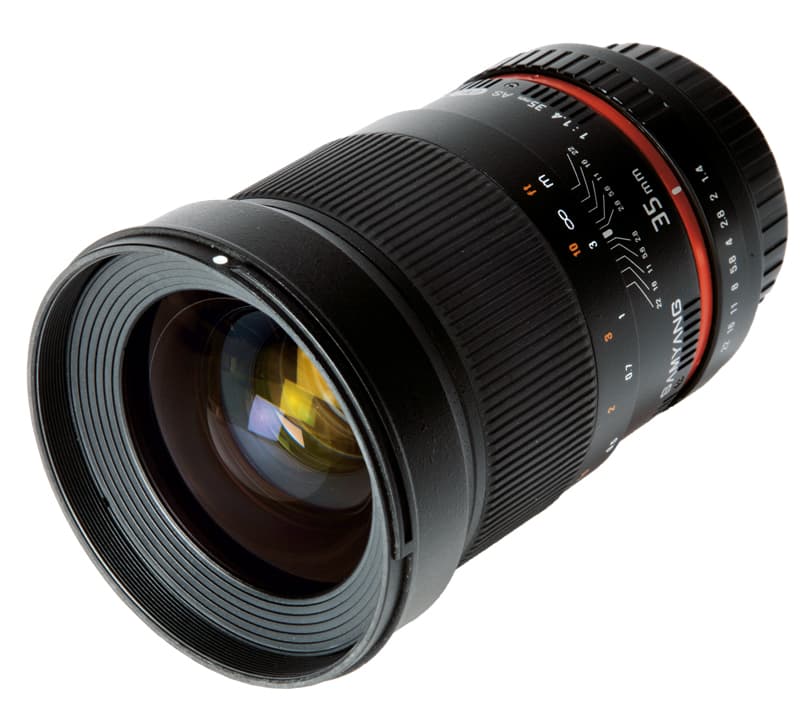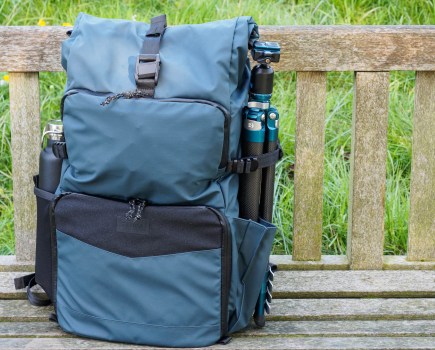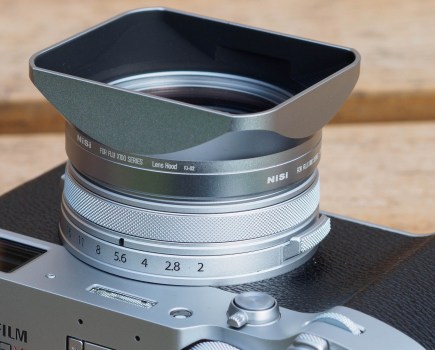Samyang has been relatively quiet in recent years, but the company’s recent spate of lens launches has seen some very interesting offerings. Our initial impressions are that these lenses are generally well made, and offer very impressive optical quality at a staggeringly affordable price.
The Samyang 35mm f/1.4 AS UMC is the company’s most expensive lens to date, but at a street price of around £320 it is only about 25% of the price of a comparable optic from the likes of Canon, Nikon and Sony. This means that the Samyang model is around £1,000 cheaper than its rivals.
Samyang’s 35mm f/1.4 optic is a full-frame model, but it will work equally well on APS-C-format cameras giving roughly a 55mm field of view, depending on the mount. The lens is available in Nikon F, Canon EF, Pentax KAF, Sony Alpha, Samsung NX and four thirds mounts, the latter providing a 70mm focal length. Full-frame users will appreciate the 35mm focal length as a solid all-round lens that is typically associated with reportage, while APS-C-format users may see this as an ideal portrait optic.
However, one of the biggest downsides is something that afflicts all current Samyang lenses: it is manual focus only. While this may not appeal to all photographers, what will is the high optical quality.
Features
While the price is a major feature of this lens, there is actually much more to it than that.
It features a floating lens system of the same type found in the equivalent Canon optic and certain macro lenses. This enhances the internal focusing system for close focusing and, as a result, the Samyang lens focuses to an impressive 30cm, making it ideal for both close-ups and environmental portraits.
Internally, the optical construction is made up of 12 elements in 10 groups. Two of these are described as High Refraction (HR), while one is an aspherical element to minimise chromatic aberration.

Image: The 35mm length is ideal for full-length portraits, although it takes practice and patience to focus manually with precise accuracy, using a shallow depth of field
Build and handling
We tested the Canon-mount version and, compared with its rivals, the Samyang 35mm f/1.4 lens is the biggest and heaviest, measuring 111x83mm and a reassuringly weighty 660g. Its 77mm filter diameter is also big for its type. Made from a tough plastic with solid metal mounts, the quality of craftsmanship is evident.
With the exception of the Nikon-mount version there are no electronic contacts on the rear lens mount, which means that digital users will find limited metadata regarding exposure settings. If this data is a crucial reference point for your photography, then you will have to get used to making a log of your shooting information.
As a manual-focus lens, it is a relief that the Samyang’s manual-focus ring is a dominant part to the lens exterior and comfortably reached. It is dampened beautifully and operates smoothly. When focusing manually, the inner focus tube moves rather than the length of the lens.
The aperture range is from f/1.4 to f/22, which is clearly marked on the ring at the base of the lens. It can be changed in 1⁄2 stops except between f/1.4 and f/2, and between f/16 and f/22. The lens ring controls the aperture in all but the Nikon-fit model, which features aperture coupling so the aperture can also be controlled in-camera.
If you stop down the aperture, the viewfinder becomes darker. This makes viewing a little tricky, especially when stopped down all the way to f/22. Photographers who regularly use smaller apertures may find the darker viewfinder a hindrance. This will also be the case in live view, although some live view systems will brighten for composition.
The lens is supplied in a velvet-effect case and comes with a petal-type hood.
Focusing
Whether or not the lack of autofocus affects your images will depend on your type of photography. Naturally, at 35mm this lens is good for reportage.
Although AF is useful for this, the focus distances are clearly marked on the top of the lens, and with a little practice it is easy to get close to the correct focus prior to checking the viewfinder or live view.
A good eye is required for the wider apertures, where the depth of field and therefore correct focus can be down to a matter of millimetres. In busy and erratic scenes, a manual-focus lens will result in a lower hit ratio, but it should generally keep the eye of the photographer sharp.

Image: Of the 12 elements, the two white elements are high refraction (HR) and the yellow is an aspherical type
Optical quality
I am pleased with the optical quality of the Samyang lens. Our resolution charts show it to be pin sharp, with minor softness at f/1.4 and f/22. Prime lenses are usually sharper than zoom optics, but the level of sharpness on display here is remarkable considering the price of the lens. Detail in the eyes and eyebrows of portraits is very well defined. Resolution detail is consistent along the entire aperture range, with a drop-off at f/22.
 Image: An f/1.4 aperture is useful for dark interiors, such as in this cake shop
Image: An f/1.4 aperture is useful for dark interiors, such as in this cake shop
At f/1.4, image detail is slightly softer with less contrast, but I would expect a drop-off in image clarity at the widest aperture setting and this is still very good. Stopping down to anywhere between f/2.8 and f/11 shows the image quality at its most crisp.
As I would expect from a lens that opens up to f/1.4, vignetting is noticeably present at wider apertures. By f/2.8 it is less noticeable and by f/4 the vignetting is all but gone. Edge detail is almost as strong as in the centre of the frame, which is impressive.
Minor barrel distortion is evident in a controlled setting with a test subject, but it is nothing to worry about in real-world situations. Many lenses at this focal length show a similar level of distortion, and most of this can be controlled in-camera or through software with distortion correction.
Chromatic aberration is well controlled, thanks in part to the aspherical lens element. At the widest aperture I noticed fringing in edge detail, but stop down to around f/4 and it is much less apparent. This is yet another area of optical quality where the lens performs very well indeed.
As this is a relatively wide lens, out-of-focus areas are not as extreme as on a more telephoto optic, so having a widest setting of f/1.4 is very useful. However, the character of out-of-focus areas (bokeh) is still an important consideration for those using this lens for its wider apertures, and here the quality is very good.
Resolution chart

We placed the Samyang 35mm f/1.4 AS UMC on a Canon EOS-1Ds Mark III body and shot our standard resolution test chart. The images are across the entire aperture range.
Our verdict
The Samyang 35mm f/1.4 AS UMC lens is a pleasure to use. It is well constructed and handles beautifully. What’s most impressive is the high optical quality in all fields in a lens that costs roughly a quarter of the price of its competitors.
The restriction to manual focus is a downside, but if you can manage your photography despite this constraint, this lens should find its way into your kit bag. We can’t wait for the day when Samyang incorporates autofocus into its lenses.







